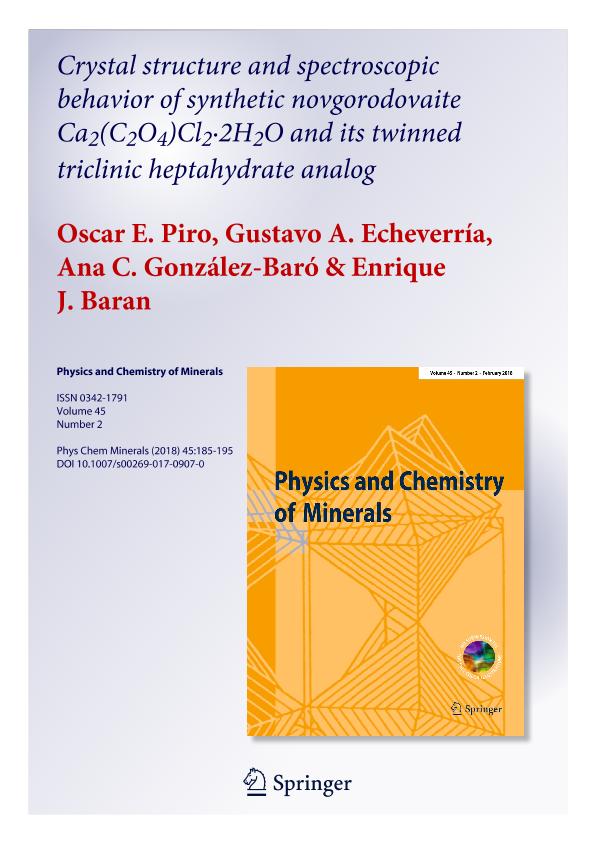Mostrar el registro sencillo del ítem
dc.contributor.author
Piro, Oscar Enrique

dc.contributor.author
Echeverría, Gustavo Alberto

dc.contributor.author
Gonzalez Baro, Ana Cecilia

dc.contributor.author
Baran, Enrique José

dc.date.available
2019-10-29T17:27:03Z
dc.date.issued
2018-02
dc.identifier.citation
Piro, Oscar Enrique; Echeverría, Gustavo Alberto; Gonzalez Baro, Ana Cecilia; Baran, Enrique José; Crystal structure and spectroscopic behavior of synthetic novgorodovaite Ca2(C2O4)Cl2·2H2O and its twinned triclinic heptahydrate analog; Springer; Physics And Chemistry Of Minerals; 45; 2; 2-2018; 185-195
dc.identifier.issn
1432-2021
dc.identifier.uri
http://hdl.handle.net/11336/87551
dc.description.abstract
Synthetic novgorodovaite analog Ca2(C2O4)Cl2·2H2O is identical to its natural counterpart. It crystallizes in the monoclinic I2/m space group with a = 6.9352(3), b = 7.3800(4), c = 7.4426(3) Å, β = 94.303(4)°, V = 379.85(3) Å3 and Z = 2. The heptahydrate analog, Ca2(C2O4)Cl2·7H2O, crystallizes as triclinic twins in the P1 ¯ space group with a = 7.3928(8), b = 8.9925(4), c = 10.484(2) Å, α = 84.070(7), β = 70.95(1), γ = 88.545(7)°, V = 655.3(1) Å3 and Z = 2. The crystal packing of both calcium oxalate?chloride double salts favors the directional bonding of oxalate, C2O4 2−, ligands to calcium ions as do other related calcium oxalate minerals. The π-bonding between C and O atoms of the C2O4 2− oxalate group leaves sp2-hydridised orbitals of the oxygen atoms available for bonding to Ca. Thus, the Ca?O bonds in both calcium oxalate?chloride double salts are directed so as to lie in the plane of the oxalate group. This behavior is reinforced by the short OO distances between the oxygens attached to a given carbon atom, which favors them bonding to a shared Ca atom in bidentate fashion. Strong bonding in the plane of the oxalate anion and wide spacing perpendicular to that plane due to repulsion between oxalate π-electron clouds gives rise to a polymerized structural units which are common to both hydrates, explaining the nearly equal cell constants ~7.4 Å which are defined by the periodicity of Ca-oxalate chains in the framework (monoclinic b ≈ triclinic a). When compared with novgorodovaite, the higher water content of Ca2(C2O4)Cl2·7H2O leads to some major differences in their structures and ensuing physical properties. While novgorodovaite has a three-dimensional framework structure, in the higher hydrate, the highly polar water molecules displace chloride ions from the calcium coordination sphere and surround them through OwHCl hydrogen bonds. As a result, polymerization in Ca2(C2O4)Cl2·7H2O solid is limited to the formation of two-dimensional Ca2(C2O4)(H2O)5 slabs parallel to (001), inter-layered with hydrated chloride anions. This layered structure accounts for (001) being both a perfect cleavage and a twin interface plane. The infrared and Raman spectra of both salts are also briefly discussed.
dc.format
application/pdf
dc.language.iso
eng
dc.publisher
Springer

dc.rights
info:eu-repo/semantics/openAccess
dc.rights.uri
https://creativecommons.org/licenses/by-nc-sa/2.5/ar/
dc.subject
HEPTAHYDRATE ANALOG
dc.subject
POWDER X-RAY DIFFRACTION
dc.subject
SINGLE-CRYSTAL X-RAY STRUCTURE
dc.subject
SYNTHETIC NOVGORODOVAITE
dc.subject
VIBRATIONAL SPECTRA
dc.subject.classification
Física de los Materiales Condensados

dc.subject.classification
Ciencias Físicas

dc.subject.classification
CIENCIAS NATURALES Y EXACTAS

dc.title
Crystal structure and spectroscopic behavior of synthetic novgorodovaite Ca2(C2O4)Cl2·2H2O and its twinned triclinic heptahydrate analog
dc.type
info:eu-repo/semantics/article
dc.type
info:ar-repo/semantics/artículo
dc.type
info:eu-repo/semantics/publishedVersion
dc.date.updated
2019-10-22T16:32:00Z
dc.identifier.eissn
0342-1791
dc.journal.volume
45
dc.journal.number
2
dc.journal.pagination
185-195
dc.journal.pais
Alemania

dc.description.fil
Fil: Piro, Oscar Enrique. Consejo Nacional de Investigaciones Científicas y Técnicas. Centro Científico Tecnológico Conicet - La Plata. Instituto de Física La Plata. Universidad Nacional de La Plata. Facultad de Ciencias Exactas. Instituto de Física La Plata; Argentina. Universidad Nacional de La Plata. Facultad de Ciencias Exactas; Argentina
dc.description.fil
Fil: Echeverría, Gustavo Alberto. Consejo Nacional de Investigaciones Científicas y Técnicas. Centro Científico Tecnológico Conicet - La Plata. Instituto de Física La Plata. Universidad Nacional de La Plata. Facultad de Ciencias Exactas. Instituto de Física La Plata; Argentina. Universidad Nacional de La Plata. Facultad de Ciencias Exactas; Argentina
dc.description.fil
Fil: Gonzalez Baro, Ana Cecilia. Consejo Nacional de Investigaciones Científicas y Técnicas. Centro Científico Tecnológico Conicet - La Plata. Centro de Química Inorgánica "Dr. Pedro J. Aymonino". Universidad Nacional de La Plata. Facultad de Ciencias Exactas. Centro de Química Inorgánica "Dr. Pedro J. Aymonino"; Argentina. Universidad Nacional de La Plata. Facultad de Ciencias Exactas; Argentina
dc.description.fil
Fil: Baran, Enrique José. Consejo Nacional de Investigaciones Científicas y Técnicas. Centro Científico Tecnológico Conicet - La Plata. Centro de Química Inorgánica "Dr. Pedro J. Aymonino". Universidad Nacional de La Plata. Facultad de Ciencias Exactas. Centro de Química Inorgánica "Dr. Pedro J. Aymonino"; Argentina. Universidad Nacional de La Plata. Facultad de Ciencias Exactas; Argentina
dc.journal.title
Physics And Chemistry Of Minerals

dc.relation.alternativeid
info:eu-repo/semantics/altIdentifier/doi/http://dx.doi.org/10.1007/s00269-017-0907-0
dc.relation.alternativeid
info:eu-repo/semantics/altIdentifier/url/https://link.springer.com/article/10.1007%2Fs00269-017-0907-0
Archivos asociados
